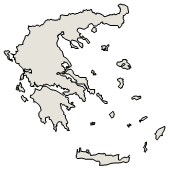

Administrative Region : Epirus
Regional unit : Arta
Vigla (Βίγλα) Arta
| Municipal unit Amvrakikos |
|---|
| Community Aneza |
| Aneza (Ανέζα, η) |
| Apomero (Απόμερο, το) |
| Mytikas (Μύτικας, ο) |
| Community Vigla |
| Vigla (Βίγλα, η) |
| Community Gavria |
| Gavria (Γαβριά, η) |
| Community Kalogeriko |
| Kalogeriko (Καλογερικό, το) |
| Community Koronisia |
| Koronisia (Κορωνησία, η) |
| Community Polydroso |
| Palaioskamia (Παλαιοσκαμιά, η) |
| Polydroso (Πολύδροσο, το) |
| Community Rachi |
| Rachi (Ράχη, η) |
| Community Strongyli |
| Strongyli (Στρογγυλή, η) |
| Community Psathotopi |
| Psathotopi (Ψαθοτόπιον, το) |
Greece :
A - B - C - D - E - F - G - H - I - J - K - L - M -
N - O - P - Q - R - S - T - U - V - W - X - Y - Z
Retrieved from "http://en.wikipedia.org/"
All text is available under the terms of the GNU Free Documentation License
| Ancient Greece
Science, Technology , Medicine , Warfare, , Biographies , Life , Cities/Places/Maps , Arts , Literature , Philosophy ,Olympics, Mythology , History , Images Medieval Greece / Byzantine Empire Science, Technology, Arts, , Warfare , Literature, Biographies, Icons, History Modern Greece Cities, Islands, Regions, Fauna/Flora ,Biographies , History , Warfare, Science/Technology, Literature, Music , Arts , Film/Actors , Sport , Fashion --- |

